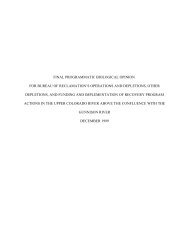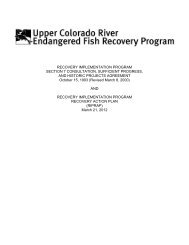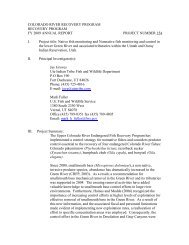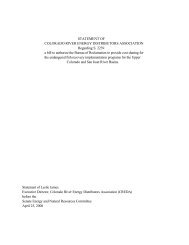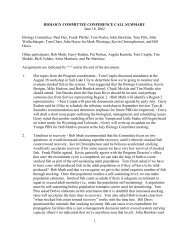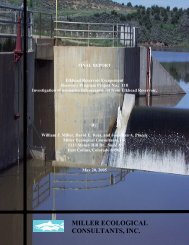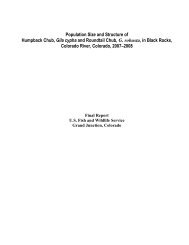K. R. Bestgen, K. A. Zelasko, and G. C. White. Monitoring ...
K. R. Bestgen, K. A. Zelasko, and G. C. White. Monitoring ...
K. R. Bestgen, K. A. Zelasko, and G. C. White. Monitoring ...
Create successful ePaper yourself
Turn your PDF publications into a flip-book with our unique Google optimized e-Paper software.
probabilities in the Upper Colorado River basin are often in the range of 0.02–0.05, so the<br />
likelihood of being able to correctly detect a declining survival rate of 10% is often < 25%. This<br />
is not a desirable attribute of a high-quality monitoring program.<br />
Correct model selection occurred at higher rates when the decline in survival rate was<br />
increased to 20%, <strong>and</strong> especially so, when recapture probabilities were 0.05 or higher. The<br />
simulation results could be considered in the framework of a power analysis, whereby the<br />
statistical power to correctly detect a true trend is equal to the percent of the simulations that are<br />
correctly chosen. On the other h<strong>and</strong>, the proportion incorrectly chosen is the chance that the<br />
incorrect model will be chosen even when the state described in the simulation, here a decline in<br />
survival rate, is true. For example, in Table 9, where detection of a 20% change is survival rate<br />
is desired <strong>and</strong> recapture probability is 0.05, data would incorrectly identify that no change in<br />
survival occurred 22% of the time (100% – 78% = 22%); thus, managers would have about a 1 in<br />
5 chance of not detecting the true decline in survival rate with the given sampling <strong>and</strong> population<br />
characteristics in place. It should also be noted that these are likely the most optimistic levels of<br />
correct model selection, <strong>and</strong> that situations encountered in the wild (e.g., highly variable<br />
recapture rates, other factors that reduce tag detection, <strong>and</strong> sampling error) will almost certainly<br />
reduce the likelihood that a decline in survival rate at the specified level will be detected; this is<br />
true for all simulated data.<br />
The second set of simulation results that tested for group differences in survival rates<br />
with varying numbers of released fish over a 3-year period were consistent with the ones just<br />
discussed for time-varying survival rates in that a smaller decline in survival of 10% is more<br />
difficult to detect correctly than a decline of 20%, <strong>and</strong> that increasing recapture probability<br />
increases the chances of correctly detecting a true group difference (Table 10). Number of fish<br />
stocked in the group annually has an effect similar to recapture rates, in that larger numbers of<br />
stocked fish result in a higher chance of correctly detecting a decline of the specified magnitude<br />
under a given set of sampling conditions. For example, if managers wanted to be able to detect a<br />
10% difference in group survival rate over a three-year period with a sampling program<br />
sufficient to obtain a 0.10 recapture rate, they could expect correct detection of group survival<br />
differences less than half (47%) of the time if 1,000 fish were stocked annually. The correct rate<br />
of detection of such a decline in survival rate increases to 84% when 2,000 fish were stocked<br />
annually <strong>and</strong> to 99% when 5,000 fish were stocked. In general, smaller batches of fish (n<br />
=1,000) should be used only when detecting larger (e.g., 20%) changes in survival rates <strong>and</strong><br />
42



